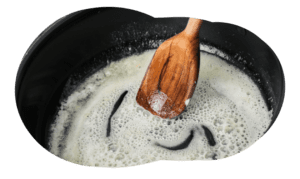Taste Europe | Butter of France announced a partnership with Cozymeal, a leading online platform connecting consumers where they reside with world-class chefs, mixologists, food tour guides and more to teach culinary enthusiasts the backbone of French cuisine – the 5 mother sauces. These sauces are the building blocks of classic dishes in many international cuisines and are a staple in traditional French culinary arts. For culinary students, mastering the 5 mother sauces is a requirement and for enthusiasts, the mother sauces provide a basic jumping off point as these sauces can be turned into endless variations – also called daughter sauces. The new video series is available on Taste Europe, Butter of France.

“The common thread in all mother sauces is butter from France, of course. It’s the butter that makes ‘la différence,’” said Charles Duque, Managing Director of the Americas for the French Dairy Board. “Partnering with Cozymeal on this effort provides a platform to showcase the importance of using high-quality ingredient such as French butter, especially for making these sauces in French gastronomy.”
Recipes for sauces made with butter are a time-honored tradition and were codified in the early 19th century by chef and chef pâtissier, Marie-Antoine Carême, who developed four mother sauces as the cornerstone of French cuisine. Decades later, Georges Auguste Escoffier built upon Carême’s work with an updated list of these mother sauces in “Le Guide Culinaire,” which also designated a fifth sauce. Each of the mother sauces is made from a base liquid, combined with a thickening agent.
The five French mother sauces are béchamel, velouté, espagnole, hollandaise and tomate. French butter was traditionally used in mother sauces and still is the top choice among chefs worldwide.
“European butter – specifically French butter – is unique because it contains a higher percentage of butterfat (min. 82%). More fat means less water. It is most often cultured, and the cream is churned longer, which results in a creamier texture and a unique flavor, perfect for luxurious sauces,” said Ivan Beacco, a European chef now based in New York City.
The French consume more than 16 pounds of butter per year and per capita, according to data supplied by the Department of the Ministry of Agriculture and Food. France has three Protected Designation of Origin (PDO) butters that every French chef is familiar with: Charentes-Poitou butter, Isigny Butter and Bresse Butter. “Butter with the PDO label is a protected butter that signifies a production guideline regulating milk, production process, terroir and savoir-faire. If a butter has this symbol, it means they are produced following certain guidelines and only using the milk from a specific region,” said Duque.
Mother sauces add richness, texture and flavor and help to bring a dish together. The name “mother sauce” refers to the fact that each one is the foundation for countless variations. French butter is an exceptional base for developing extraordinary sauces to upgrade everything from meats and vegetables to soups and pasta.
“In America, mother sauces are the foundation of many beloved dishes,” according to Duque. Béchamel is the base of creamy homemade macaroni and cheese or lasagna. Velouté is the starting point for comforting chicken pot pie and shrimp bisque. A rich French brown sauce paired with filet mignon begins with Espagnole. Hollandaise is often drizzled over asparagus and graces one of the most popular brunch dishes, Eggs Benedict.
Cooks can master the five mother sauces like a chef with easy step-by-step videos available on www.TasteEurope.com/mothersauces. More recipes and tips can be found on social media @TasteEurope and www.TasteEurope.com.